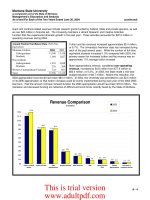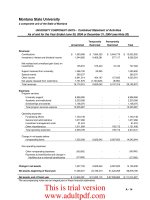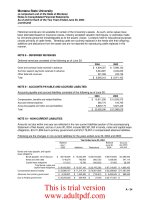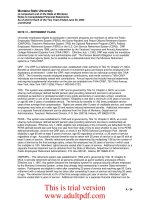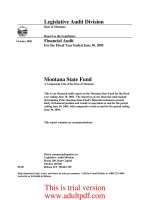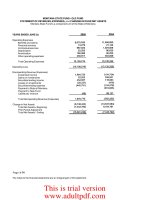Legislative Audit Division State of Montana Report to the Legislature December 2006 Financial_part4 potx
Bạn đang xem bản rút gọn của tài liệu. Xem và tải ngay bản đầy đủ của tài liệu tại đây (1.03 MB, 10 trang )
Montana State University
(a component unit of the State of Montana)
Notes to Consolidated Financial Statements
As of and for Each of the Years Ended June
30
(continued)
are recognized when earned, and expenses are recorded when an obligation has been incurred. The University has the
option to apply all Financial Accounting Standards Board (FASB) pronouncements issued after November 30,1989,
unless FASB conflicts with GASB. The State of Montana has elected not to apply FASB pronouncements issued after
the applicable date.
SIGNIFICANT ACCOUNTING POLICIES
Cash equivalents
-
For purposes of the statement of cash flows, the University considers its unrestricted, highly
liquid investments purchased with an original maturity of three months or less to be cash equivalents. Funds
invested in the Short Term Investment Pool with the Montana Board of Investments are considered cash equivalents,
as are certain investments held by trustees.
Investments
-
The University accounts for its investments at fair value in accordance with GASB Statement No.
3
1
Accounting and Financial Reporting for Certain Investments and for External Investment Pools.
Investment income
is recorded on the accrual basis. All investment income, including changes in unrealized gain (loss) on the carrying
value of investments, is reported as a component of investment income.
Accounts and grants receivable
-
Accounts receivable consist of tuition and fees charged to students and auxiliary
enterprise services provided to students, faculty and staff. Accounts receivable also include amounts due from the
Federal government, state and local governments, or private sources, in connection with reimbursement of allowable
expenditures made pursuant to the University's grants and contracts. Accounts receivable are reported net of
estimated uncollectible amounts.
Allowances for uncollectible accounts
-
The University estimates the value of its receivables that will ultimately
prove uncollectible, and has reported a provision for such as an expense in the accompanying financial statements.
Inventories
-
Inventories include consumable supplies, livestock, and food items and items held for resale or recharge
within the University. Inventories are valued using First In First Out (FIFO) or specific identification methods.
Non-current cash and investments
-
Cash and investments that are externally restricted as to use are classified as
non-current assets in the accompanying statement of net assets. Such assets include endowment fund cash and
investments.
Capital assets
-
Capital assets are stated at cost or fair value at date of purchase or donation. Livestock held for
educational purposes is recorded at estimated fair value. Renovations to buildings, infrastructure, and land
improvements that
~i~cantly increase the value or extend the usell life of the structure are capitalized. Routine
repairs and maintenance and minor renovations are charged to operating expense in the year in which the expense is
incurred.
Depreciation and amortization are computed on a straight-line basis over the estimated useful lives of the respective
assets, ranging from
3
years for certain software to
75
years for certain infrastructure assets. The University has
elected to capitalize museum, fine
art
and special library collections, but does not record depreciation on those items.
Deferred revenues
-
Deferred revenues include amounts received for tuition and fees and certain auxiliary activities
prior to the end of the fiscal year but related to events occurring in the subsequent accounting period.
Deferred revenues
also include amounts received
fiom grant and contract sponsors that have not yet been earned.
Compensated absences
-
Eligible University employees earn a minimum of 8 hours sick and 10 hours annual leave
for each month worked. Eligible employees may accumulate annual leave up to twice their annual accrual, while
sick leave may accumulate without limitation. Twenty-five percent of accumulated sick leave earned after July 1,
197 1 and 100
pexcent of accumulated annual leave, if not used during employment, is paid upon termination.
Net assets
-Resources are classified in one of the following four net asset categories:
This is trial version
www.adultpdf.com
This is trial version
www.adultpdf.com
Montana State University
(a component unit of the State of Montana)
Notes to Consolidated Financial Statements
As of and for Each of the Years Ended June
30
(continued)
NOTE
2
-CASH DEPOSITS, CASH EQUIVALENTS
AND
INVESTMENTS
Cash deposits
-The University must comply with State statutes, which generally require that cash and investments
remain on deposit with the State treasury, and as such are subject to the State's investment policies. Certain
exceptions exist, which allow funds to be placed on deposit with trustees to satisfy bond covenants or to maximize
investment earnings through placing certain funds with recognized University foundations. Deposits with the State
treasury and other financial institutions totaled $37,947,041 at June 30,2006 and $54,822,628 at June 30,2005.
Cash equivalents
-
These amounts consist of cash held by trustees as well as in a Short Term Investment Pool
(STIP) with the Montana Board of Investments. Amounts held in STIP may be withdrawn by the University on
demand, and as such are classified as cash equivalents, even though a portion of the pool's underlying investments
may be considered noncurrent.
STIP investments are purchased in accordance with the statutorily mandated "Prudent Expert Principle." The STIP
portfolio may include asset-backed securities, commercial paper, corporate and government securities, repurchase
agreements, and variable-rate (floating-rate) instruments. These securities are purchased to provide shareholders
with a diversified portfolio earning a competitive total rate of return.
Asset-backed securities represent debt securities collateralized by a pool of mortgage and non-mortgage assets such
as trade and loan receivables, equipment leases, credit cards, etc. Commercial paper is unsecured short-term debt
with maturities ranging from
1
to 270 days. Commercial paper issued at a discount, direct or by brokers, is backed
by bank credit lines. Repurchase agreements
(REPOs) represent an agreement between a seller and a buyer, usually
of US government securities, whereby the seller agrees to repurchase the securities at an agreed upon price and
stated time. Variable-rate (floating-rate) securities pay a variable rate of interest until maturity. The STIP portfolio's
variable-rate securities float with
LIBOR (London Interbank Offered Rate).
STIP participants include both state agencies and local governments. By meeting certain conditions, STIP, as a 2a7-
like pool, is allowed to use amortized cost rather than fair value to report net assets to compute unit values. Funds
held in STIP are reported at fair value as of June 30, based on market prices supplied to the Montana Board of
Investments by its custodial bank.
Investments
-These amounts consist of U.S. Government Securities, amounts invested in the Montana Board of
Investments Trust Fund Bond Pool (TFBP), funds held in common investment pools administered by the
MSU-
Bozeman and MSU- Northern Foundations, as well
as
other funds held with trustees.
TFBP investments are purchased in accordance with the statutorily mandated "Prudent Expert Principle." The
TFBP portfolio includes securities classified as corporate, foreign government bonds, municipals, U.S. government
direct-backed, U.S. government indirect-backed, and cash equivalents. U.S. government direct-backed securities
include direct obligations of the U.S. Treasury and obligations explicitly guaranteed by the U.S. government. U.S.
govemment indirect-backed obligations include U.S. government agency and mortgage-backed securities. U.S.
government mortgage-backed securities reflect participation in a pool of residential mortgages.
The TFBP portfolio includes structured financial instruments known as REMICs (Real Estate Mortgage Investment
Conduits).
REMICs are pass-through vehicles for multiclass mortgage-backed securities. Strip investments
represent the separate purchase
of
the principal and interest cash flows of a mortgage security. These securities,
purchased for portfolio diversification and a competitive rate of return, are identified and reported as U.S.
government indirect-backed securities in the investment risk and portfolio disclosures.
TFBP fixed income securities pay a fixed rate of interest until maturity while the variable-rate (floating-rate)
securities pay a variable interest rate until maturity. The TFBP variable-rate securities float with
LIBOR (London
Interbank Offered Rate). Investments are presented in the TFBP Statement of Net Asset Value at fair value. Fair
values for securities are determined primarily by reference to market prices supplied to the Board of Investments by
its custodial bank, State Street Bank.
This is trial version
www.adultpdf.com
Montana State University
(a component unit of the State of Montana)
Notes to Consolidated Financial Statements
As of and for Each of the Years Ended June 30 (continued)
The MSU- Bozeman and MSU- Northern Foundation Pools consist of certain endowment finds held in common
investment pools. Such pools are administered by the separate Foundations and managed in accordance with
investment policies in effect at each.
Securities lending transactions -During fiscal years 2006 and 2005, State Street Bank loaned, on behalf of the
Montana Board of Investments, certain securities held by State Street, as custodian, and received U.S. dollar
currency cash, U.S. government securities, and irrevocable bank letters of credit as collateral. State Street does not
have the ability to pledge or sell collateral securities unless the borrower defaults.
The Board did not impose any restrictions during fiscal years 2006 and 2005 on the amount of the loans that State
Street Bank made on its behalf. There were no failures by any borrowers to return loaned securities or pay
distributions thereon during fiscal years 2006 and 2005. Moreover, there were no losses during fiscal years 2006 and
2005 resulting
fiom a default of the borrowers or State Street Bank.
During fiscal years 2006 and 2005, the Board and the borrowers maintained the right to terminate all securities
lending transactions on demand. The cash collateral received on each loan was invested, together with the cash
collateral of other qualified plan lenders, in a collective investment pool, the Securities Lending Quality Trust,
which has a weighted average maturity of 35 and 49 days, respectively as of June 30,2006 and 2005. The
relationship between the average maturities of the investment pool and the Board's loans was affected by the
maturities of the loans made by other plan entities that invested cash collateral in the collective investment pool,
which the Board could not determine. At year-end, the University had no credit risk exposure to borrowers because
the amounts the Board owes the borrowers exceed the amounts receivable
fiom the borrowers.
The University maintained security lending cash collateral of $1,537,765 at June 30, 2006, and $1,203,088 at June
30, 2005.
Investment risks
-
Effective June 30,2005, the University implemented the provisions of Governmental
Accounting Standards Board (GASB) Statement No. 40
-
Deposit and Investment Risk Disclosures.
Detailed asset
maturity and other information demonstrating risk associated with the State of Montana Board of Investments STIP
and TFBP is contained in the State of Montana Board of Investments financial statements, and may be accessed by
contacting the Board of Investments at P.O. Box 200126, Helena, MT 59620-0126. Investment risks are described
in the following paragraphs.
Credit Risk
-
Credit risk is defined as the risk that an issuer or other counterparty to an investment will not fulfill
its obligation. With the exception of the U.S. government securities, all STIP securities and TFBP fixed income
instruments have credit risk as measured by major credit rating services. The Board of Investments' policy requires
that STIP securities have the highest investment grade rating in the short term category by at least one Nationally
Recognized Statistical Rating Organizations (NRSRO). The six
NRSROs include Standard and Poor, Moody, Duff
and Phelps, Fitch, IBCA and Thompson's Bank Watch. The Board of Investment's policy requires TFBP fixed
income investments, at the time of purchase, to be rated an investment grade as defined by Moody's or by Standard
&
Poor's (S&P) rating services.
U.S. government securities are guaranteed directly or indirectly by the U.S. government. Obligations of the U.S.
government or obligations explicitly guaranteed by the U.S. government are not considered to have credit risk and do
not require disclosure of credit quality.
Custodial Credit Risk
-
Custodial credit risk for investments is the risk
that,
in the event of the failure of the
counterparty to a transaction, a government will not be able to recover the value of the investment or collateral
securities that are in the possession of an outside party. As of June 30,2006 and 2005, all STIP and TFBP securities
were registered in the nominee name for the Montana Board of Investments and held in the possession of the Board's
custodial bank, State Street Bank. According to the STIP Investment Policy, "repurchase agreements require electronic
delivery of U.S. Government Treasury collateral, priced at 102 percent market value, to the designated State of
Montana Federal Reserve Bank account." The
TFBP's State Street repurchase agreement was purchased in the State of
Montana Board of Investments name.
This is trial version
www.adultpdf.com
Montana State University
(a component unit of the State of Montana)
Notes to Consolidated Financial Statements
As of and for Each of the Years Ended June
30
(continued)
Concentration of Credit Risk
-
Concentration of credit risk is the risk of loss athibuted to the magnitude of a
government's investment in a single issuer. Investments issued or explicitly guaranteed by the U.S. government are
excluded
fiom the concentration of credit risk requirement. The STIP Investment Policy Statement does not
specifically address concentration of credit risk. The policy does provide for "minimum three (3%) percent or
$15
million, whichever is higher, to be invested in Repurchase Agreements." As of June 30,2006 and 2005, there were no
single issuer investments that exceeded
5%
of the STIP portfolio. According to the TFBP Investment Policy, "with the
exception of U.S. government indirect-backed (agency) securities, additional TFBP portfolio purchases will not be
made if the credit risk exceeds 2 percent of the portfolio at the time of purchase." As of June 30,2006 and 2005, the
TFBP had concentration of credit risk exposure to the Federal Home Loan Mortgage Corp of 7.75% and
8.19%,
respectively.
Interest Rate Risk-
Interest rate risk is the risk that changes in interest rates will adversely affect the fair value of an
investment. According to GASB Statement No. 40, interest rate disclosures are not required for STIP since STIP is a
2a-7-like pool. The TFBP investment policy does not formally address interest rate risk.
The State of Montana has selected the effective duration method to disclose interest rate risk. The University's
investments are categorized below to disclose interest rate and credit risk as of June 30,2006. Credit risk reflects the
security quality rating, by investment security type, as of the June 30 report date. Interest rate risk is disclosed using
effective duration. If a security investment type is
unrated, the quality type is indicated by NR. Although STIP and
TFBP investments have been rated by investment security type, neither has been rated by an NRSRO.
Cash equivalents and investments are categorized as follows at June 30,2006:
Fair Value
Moody's Effective
Credit Quality Duration
Rating at at June
Security Type
State of Montana Short Term Investment Pool
U. S. Bank Money Market Funds (collateralized
by
U.S.
Bank pool, not in the University's name)
State of Montana Trust Fund Bond Pool*
Foundation Pooled Cash and Investments*
U.S. Treasury Notes
U.S. Treasury Bills
U.
S. Bank Certificates of Deposit (collateralized
by
U.
S. Bank pool, not
in
the University's name)
U.
S. Bank Guaranteed Investment Contracts (non-
collateralized)
Total Cash Equivalents
&
Investments
2006 2005 June 30,2006 30,2006
$
51,908,470
$
29,571,127 NR
N/A
1,000,000 1,000,000 Aal 1.46
Securities Lending Collateral Investment Pool
$
1,537,765
$
1,203,088
NR
N/
A
a
*
TFBP
and Foundation investments are not intended for withdrawal.
Land grant earnings
-
The University benefits from two separate land grants which total 240,000 acres. The first
granted 90,000 acres for the University under provisions of the
Morrill Act of 1862. The second, under the Enabling
Act of 1889, granted an additional 50,000 acres for agricultural institutions and 100,000 acres for state
normal
schools.
Under provisions of both grants, income from the sale of land and land assets must be reinvested and constitutes,
along with the balance of the unsold land, a perpetual endowment fund. The State of Montana, Board of Land
Commissioners, administers both grants and holds all endowed assets. The University's land grant assets are not
reflected in these financial statements, but are included as a component of the State of Montana Basic Financial
Statements that are prepared annually and presented in the Montana Comprehensive Annual Financial Report.
This is trial version
www.adultpdf.com
Montana State University
(a component unit of the State of Montana)
Notes to Consolidated Financial Statements
As
of and for Each of the Years Ended June
30
(continued)
Investment income from the perpetual endowment is distributed periodically to the University by the State of
Montana, Board of Land Commissioners, and is reported as revenue in the accompanying financial statements. The
University has currently pledged such income to the retirement of revenue bond indebtedness.
In addition to distributed endowment income, the University also receives revenue generated from trust land timber
sales. The University has the flexibility to designate timber sales revenues as either distributable or for
reinvestment, should it choose to expend the funds for certain specified purposes.
NOTE 3
-
ACCOUNTS
AND
GRANTS RECEIVABLE
Accounts receivable consisted of the following as of June 30:
2006 2005
Accounts receivable
$
6,189,354
$
5,525,052
Other receivables, including private grants and contracts 3,403,887
3,461,518
Gross accounts and grants receivable 9,593,241 8,986,570
Less allowance for uncollectible accounts (2,113,589) (2,064,839)
Net accounts and grants receivable
$
7,479,652
$
6,921,731
NOTE
4
-
INVENTORIES
Inventories consisted of the following
as
of June 30:
2006 2005
Bookstore
$
1,065,690
$
1,183,261
Food services 295,283 293,247
Facilities services
229,68
1
248,759
Livestock
555,688 5 18,406
Other 582,213 555,357
Total inventories
$
2,728,555
$
2,799,030
NOTE
5
-
PREPAID EXPENSES
Prepaid expenses consisted of the following
as
of June 30:
2006 2005
Library subscriptions
$
727,000
$
1,401,032
Other
1,260,100 1,063,612
Total prepaid expenses
$
1,987,100
$
2,464,644
NOTE
6
-
LOANS RECEIVABLE
Total loans receivable balances at June 30,2006 and 2005 were $21,696,198 and $21,802,297, respectively.
Student loans made under the Federal
Perkins Loan Program constitute the majority of the University's loan
balances. Included in non-current liabilities as of June 30,2006 and 2005 are $2 1,159,764 and
$20,9 10,053 that
would be refundable to the Federal Government, should the University choose to cease participation in the Federal
Perkins Loan program.
The Federal portions of interest income and loan program expenses are shown as additions to and deductions from
the amount due to the Federal government, and not as operating transactions,
in
the accompanying financial
statements.
This is trial version
www.adultpdf.com
Montana State University
(a component unit of the State of Montana)
Notes to Consolidated Financial Statements
As of and for Each of the Years Ended June
30
(continued)
NOTE
7
-
CAPITAL ASSETS
Following are the changes in capital assets for the years ended June
30,2006
and
2005:
Year Ended June
30,2006
Balance Balance
July 1,2005 Additions Retirements Transfers June
30,2006
Capital assets not being depreciated:
Land
$
4,240,069
$
2,268,301
$
-
S
-
$
6,508,370
Museum and fine art 4,3 19,153 46,500
-
4,365,653
Library special collections 3,460,950
-
3,460,950
Livestock for educational purposes 2,963,396 36,265
-
2,999,661
Construction work-in-progress 12,033,105 13,663,656 (57,359) (9,642,612) 15,996,790
Total capital assets not
being depreciated
27,016,673 16,014,722 (57359) (9,642,612) 33,33 1,424
Other capital assets:
Furniture and equipment 91,772,607 8,111,418 (3,669,787)
-
96,214,238
Library materials 57,412,116 2,099,952 (180,761)
-
59,331,307
Buildings 168,420,836 1,798,610 4,208,002 174,427,448
Building improvements 126,505,666 5 16,294 5,114,825 132,137,785
Land improvements 13,286,580 3 19,785 13,606,365
Infrastructure 32,128,077
-
32,128,077
Total other capital assets 489,526,882 12,526,274 (3,850,548) 9,642,612 507,845,220
Accumulated depreciation (275,159,931) (20,329,493) 3,050,933
-
(292,438,491)
Other capital assets, net
214,366,951
(7,803,219) (799,615) 9,642,612
.
215,406,729
Intangible
assets,
net
781,195
45,102 (333,744)
492,553
Capital Assets, net
$
242,164,819
$
8,256,605
$
(1,190,718)
$
-
$
249,230,706
Historical records are not available for certain of the University's assets. As such, some values have been estimated
based on insurance values, industry-accepted valuation techniques, or estimates made by University personnel
knowledgeable as to the assets' values. Livestock held for educational purposes consist primarily of cattle herds.
Breeding cattle are routinely replaced in the herds by their offspring; additions and deductions from the asset cost
are not reported for reproducing cattle replaced
in
this manner.
This is trial version
www.adultpdf.com
Montana State University
(a component unit of the State of Montana)
Notes to Consolidated Financial Statements
As of and for Each of the Years Ended June
30
(continued)
Year Ended June
30,2005
Balance Balance
July 1,2004 Additions Retirements
Transfers June 30,2005
Capital assets not being depreciated:
Land
$
4,240,069
$
-
$
-
$
-
$
4,240,069
Museum and fine art 4,319,153
-
4,319,153
Library special collections 3,460,950
-
3,460,950
Livestock for educational purposes 2,757,710 205,686
-
2,963,396
Construction work-in-progress
.
5,787,224 10,785,343 (28,291) (41 171) 12,033,105
Total capital assets not
being depreciated
20,565.1 06 10,991,029 (28,291) (45 1,171) 27,016,673
Other capital assets:
Furniture and equipment 86,525,992 8,087,302 (2,840,687)
-
91,772,607
Library materials
Buildings
Building improvements
Land improvements
Infrastructure
Total other capital assets
Accumulated depreciation
Other capital assets, net
Intangible assets, net
Capital Assets, net
NOTE
8
-
DEFERRED
REVENUES
Deferred revenues consisted of the following
as
of June 30:
2006 2005
Grant and contract funds received in advance
$
3,822,003
$
4,606,360
Summer session payments received in advance
3,637,49 1 3,75 1,887
Other deferred revenues 33 1,728 265,052
Total
$
7,791,222
$
8,623,299
NOTE
9
-
ACCOUNTS PAYABLE
AND
ACCRUED LIABILTIES
Accounts payable and accrued liabilities consisted of the following
as
of June 30:
2006 2005
Compensation, benefits and related liabilities
$
16,404,156
$
16,401,248
Accrued interest expense 529,559 492,842
Accounts payable and other accrued liabilities 6,839,305 7,197,289
Total
$
23,773,020
S
24,091,379
This is trial version
www.adultpdf.com
Montana State University
(a component unit of the State of Montana)
Notes to Consolidated Financial Statements
As of and for Each of the Years Ended June
30
(continued)
NOTE 10
-
NON-CURRENT
LIABILITIES
Following are the changes in non-current liabilities for the years ended June 30,2006 and 2005:
Year Ended June
30,2006
Balance Balance Amounts
July 1, June 30, due within
2005 Additions Reductions 2006 one year
Bonds and notes payable, and capital lease
obligations
Bonds payable, net of discount
$
106,259,612
$
25,750,000
$
(4,239,928)
$
127,769,684
$
4,120,000
Notes and other debt
1,291,399 400,000 (222,697) 1,468,702 172,405
Capital lease obligations
40,973 54,610
(35,326) 60,257 27,744
Total bonds, notes and
capital lease obligations
$
107,591,984
$
26,204,610
$
(4,497,951)
$
129,298,643
$
4,320,149
7
Compensated absence liability
$
24,590,572
$
12,698,508
$
(1 1,823,312)
$
25,465,768
$
12,160,174
Advances from primary government
$
9,869,954
$
1,170,152
$
(1,229,256)
$
9,810,850
$
1,259,981
Amounts payable to Federal government
$
20,910,052
$
249,712
$
-
$
21,159,764
$
P
Amounts not due within one year are reflected
in
the non-current liabilities section of the accompanying Statement
of Net Assets, and as of June 30,2006, include $124,978,494 in bonds, notes and capital lease obligations,
$8,550,869 advances from primary government and $13,305,594 in compensated absence liabilities.
Year
Ended June
30,2005
Balance Balance Amounts
July 1, June 30, due within
2004 Additions Reductions 2005 one year
Bonds and notes payable, and capital lease
obligations
Bonds payable, net of discount
$
85,616,694
$
56,207,918
$
(35,565,000)
$
106,259,612
$
4,855,000
Notes and other debt 1,638,510 (347,111) 1,291,399 222,697
Capital lease obligations 6 1,605 14,191 (34,823) 40,973 25,816
Total bonds, notes and
capital lease obligations
$
87,316,809
$
56,222,109
$
(35,946,934)
$
107,591,984
$
5,103,513
-
Compensated absence liability
$
23,258,802
$
12,096,379
$
(10,764,609)
$
24,590,572
$
11,376,627
Advances From primary government
$
9,655,645
$
1,104,698
$
(890,389)
$
9,869,954
$
1,182,840
Amounts payable to Federal government
$
20,771,691
$
157,741
$
(19,380)
$
20,910,052
$
Amounts not due within one year are reflected in the non-current liabilities section of the accompanying Statement
of Net Assets, and as of June 30,2005, included $102,488,471 in bonds, notes and capital lease obligations,
$8,687,113 advances from primary government and $13,213,944 in compensated absence liabilities.
Interest rate exchange agreement related to long-term debt
-In March 2005, the University entered into a
forward-starting interest rate swap agreement with Deutsche Bank AG ("counterparty"). The notional amount of the
swap as of June 30,2006, is $25,750,000, and equals the University's Series J 2005 Bond principal outstanding.
The instrument converts the Series J 2005 bonds, issued July 2 1,2005, from a variable rate to an intended synthetic
fixed rate of 3.95%. The swap was executed approximately 4 months in advance of the Series
J
2005 bond issuance,
to allow the University to lock in the then current market interest rates, and its effective date was concurrent with the
bond issue date.
The counterparty to the swap has the option to unwind the swap in 2016 (the "swaption"), exposing the University
to rollover risk for the Series J Bonds' remaining term. If the
swaption is not exercised in 2016, the swap terminates
in November, 2035, at which time the Series J 2005 Bonds mature. The
swaption date of 2016 coincides with the
date at which the University's only other variable rate debt, the Series G 2003 issuance, matures. Such timing is
This is trial version
www.adultpdf.com
Montana State University
(a component unit
of
the State
of
Montana)
Notes to Consolidated Financial Statements
As of and for Each of the Years Ended June
30
(continued)
intended to limit the University's exposure to interest rate risk by allowing the Series J debt to convert to a variable
rate only after the Series
G
variable rate debt matures.
Interest rate risk is the risk that changes in interest rates will adversely affect the fair value of a financial instrument.
At June 30,2006 and 2005, the fair value of the swap was ($45,500) and ($1,615,994). Such value was provided to
the University by an independent valuation
fm
in 2006 and by the counterparty in 2005, and was calculated using
mid-market levels
as
of the close of business on June 30. The value is negative because as of June 30,2006 and
2005, the University has committed to pay a fixed rate that exceeds the June 30,2006 and 2005, Bond Market
Association Municipal Swap index ("BMA") rate, and includes the fair value of the swaption.
The University is subject to basis risk, because the interest rate which the University pays to bondholders is based on
the Municipal Auction Rate Securities ("MARS") rate, while the interest rate the University receives from the
counterparty is based on the BMA index. The difference between funds received
fiom the counterparty at BMA and
funds paid to the bondholders at MARS can result in a difference between the intended synthetic interest rate and the
effective synthetic interest rate. As of June 30,2006, the BMA rate received from the counterparty was 3.69% and
the MARS rate paid to bondholders was
3.2%, resulting in a positive basis difference of 0.49%.
Credit risk is dependent upon the credit quality rating of the counterparty. At June 30,2006 and 2005, the
University was not subject to credit risk, because the swap had
a
negative fair value. However, should interest rates
change and the fair value become positive, the University would be exposed to credit risk in the amount of the fair
value of the swap. To mitigate credit risk, the counterparty must maintain at least double-A category ratings from
both Moody's and
S&P, and must post collateral with a third party in the event of a rating downgrade.
The University or the counterparty may terminate the swap if the other party fails to perform under the terms of the
contract. If the swap is terminated, the variable rate bonds would no longer
cany a synthetic rate.
In
addition, the
University may be required to pay an amount equal to the swap's fair value, if negative.
Swap interest as of June 30,2006, netted 0.26%, which is the difference between the fixed rate of 3.95% paid to the
counterparty and 3.69% received
fiom the counterparty at the BMA rate. Repayment schedules using interest rates
in effect as of June 30,2006, are included in Note
1
I,
below.
NOTE
11
-
BONDS,
NOTES
AND
ADVANCES PAYABLE
Revenue bonds payable at June 30,2006 were
as
follows:
Series
1993
A
Payable during the year
ending June 30, Interest Rate* Principal Interest Total
2008 5.00%
$
1,208,611
$
1,206,389
$
2,415,000
2009 5.05% 1,3 14,579 1,465,421 2,780,000
2010 5.10% 1,240,881 1,539,119 2,780,000
201
1
5.15% 1,170,185 1,609,8 15 2,780,000
201 2-20 16 5.20% 1,102,465 1,677,535 2,780,000
Total cash requirements
$
6,036,721
$
7,498279
$
13,535,000
Accreted discount
on
capital appreciation bonds
5,374,674
Accreted balance
$
11,411,395
*
Effective rate calculated on deep discount bonds
This is trial version
www.adultpdf.com

